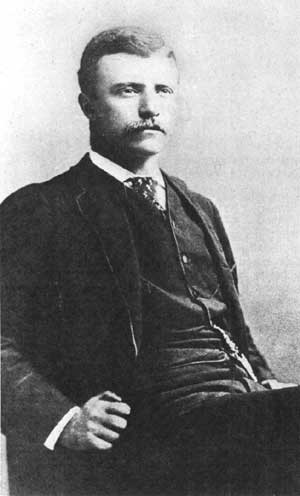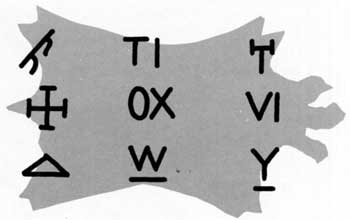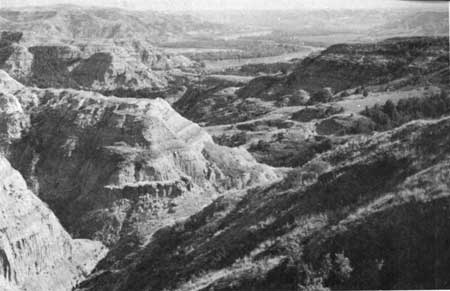|
Theodore Roosevelt and the Dakota Badlands |
 |

Theodore Roosevelt as he appeared in 1881, then a
member of the New York Legislature.
Theodore Roosevelt National Memorial Park was established to commemorate the enduring contributions of Theodore Roosevelt in the conservation of our Nation's resources and to portray his part in developing the northern open range cattle industry, a phase of history in which he was an enthusiastic participant. While in the Badlands he witnessed the passing of one of the last frontiers of the West. In 1888 he wrote, "Up to 1880 the country through which the Little Missouri flows remained as wild and almost as unknown as it was when old explorers and fur traders crossed it in the early part of the century."

ALTHOUGH Theodore Roosevelt was not an unknown public figure when he first came to the Little Missouri region in September 1883, the facts about some of his ventures there are obscure. It is known that he visited the Little Missouri Badlands frequently until 1886, less often thereafter. The contemporary evidences we have concerning him during his sporadic visits are to be found in the incomplete files of several newspapers, Roosevelt's letters to his family and a few intimate friends, the tax records of Billings and Stark Counties, and the books in which he wrote about his experiences there as a hunter and a rancher.
Roosevelt was born on October 27, 1858, at 28 East 20th Street, New York City. His family was well-to-do. As a child, he was delicate, suffering from cholera morbus, and an asthmatic condition. To overcome his physical handicaps, he early developed a fondness for sports and an interest in natural history. Roosevelt graduated from Harvard in 1880 with a developed interest in history, natural history, and writing which he maintained throughout his life.

A typical Badlands scene.
The Dakota Badlands
This region which Theodore Roosevelt knew appears to have sunk away from the surrounding world. The panorama of colorful buttes and mesas, washes, and sharply eroded valleys was carved by the Little Missouri River and its tributaries. From its source in western Wyoming the Little Missouri River winds in a northerly direction through the southeastern corner of Montana and the northwestern corner of South Dakota to join the Missouri River in west-central North Dakota.
Before the Ice Age, the waters of the Little Missouri, through the Yellowstone and Missouri Rivers, emptied into Hudson Bay. During the advance of the continental glacier the outlet of the Little Missouri was blocked by the advancing ice, which diverted its course east to join the Missouri River near Fort Berthold. The elevation of its new mouth was considerably lower than where it had joined the Yellowstone east of Williston. The resulting down-cutting of the river and its tributaries in a soil and rock cover easily susceptible to erosion contributed to the formation of the badlands topography.
This arresting topography is the result of geological processes operating over millions of years. The surface rocks were laid down to 60 million years ago. At that time streams originating in the newly uplifted Rocky Mountains flowed eastward and deposited their sediments in lagoons, lakes, and deltas that existed then. In time, these layers of sediment were changed to rock strata, which were later uplifted and are now found over a large part of western North Dakota and eastern Montana. The vegetation which flourished then was covered with sediments and later converted by tremendous pressures and other forces into lignite coal. Through the burning of the lignite, some of the upper clay beds were baked into a red brick-like rock, known locally as "scoria," which now caps many of the buttes.

|

|
|
Last Modified: Sat, Jan 17 2004 10:00:00 am PDT |


